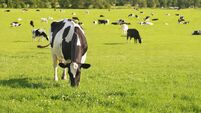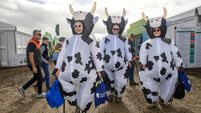National dairy herd shows positive fertility trend

Positive trends in fertility following the most recent calving report, but still room for improvement, says ICBF.
The fertility performance of the average Irish national dairy herd has improved over the last five years, according to the Irish Cattle Breeding Federation's (ICBF) most recent report.
Thef ederation has recently published its latest calving reports. The report presents data collected from more than 13,500 herds with 30 or more dairy cows.
The calving interval, the number of days between two successful calvings, has remained consistent. From 2021 to 2022, the calving interval remained static at 388 days, before experiencing a drop to 386 days in 2023.
The average calving interval experienced a further reduction in 2024 to 385 days, where it remains to date, showcasing an improvement of three days over the past five years. The ICBF has said the reduction in days shows a trend of gradual improvement in the national herd fertility and reproductive efficiency.
The average spring six-week calving rate, which is the number of heifers or cows that calve down within the first six weeks of a calving season, has increased to 69% in 2025, the highest in the last five years.
After a slight decline in 22% resulting in a six-week calving rate of 66%, the percentage has steadily risen since then. The upward trajectory of these figures shows more of the national herd are calving down within this six-week window in early spring, resulting in increased milk production.
The average percentage of heifers calving at optimum age (between 22 and 26 months) dropped marginally in 2025 to 75%. Calving at the optimum age is crucial for increasing a heifer’s lifetime productivity, reducing rearing costs and improving overall herd efficiency.
Heifers calving at optimum age were recorded at 76% in 2023 and 2024. ICBF has attributed the slight decline in 2025’s figure to environmental factors such as severe weather last spring.
In 2021, the national herd’s average lactation was 3.4, and this figure increased steadily over the next three years to 3.7 by 2023. From 2023 to 2025, it remained stable at 3.7. This upward trend indicates cows are remaining productive (lower empty rates) and lasting longer in herds, leading to increased profitability.
The percentage of replacement bred to dairy AI has steadily increased from 59% in 2021 to 62% in 2025. This upward trend shows an increasing emphasis on genetic improvement, as AI sires are considerably greater than the genetic merit of the average stock bull. Similarly, the percentage of births with a known sire has also increased from 64% in 2021 to 71% in 2025.
The top 10% of herds in 2025 are achieving a calving interval of 364 days, a spring six-week calving rate of 89%, a percentage of heifers calved at optimum age of 100%, an average lactation of 4.6 for cows in the herd, and 100% in both replacements bred by AI and births with known sire.
The bottom 10% of herds achieved a calving interval of 418 days, a spring six-week calving rate of 40%, 15% of heifers calving within optimum age, an average lactation of 2.8 for cows in the herd, and 0% in both replacements bred to AI and births with a known sire.
ICBF said although trends in fertility were positive, the national herd was still behind targets identified by Teagasc that are required to ensure a profitable dairy industry.
Regarding the results, a spokesperson for ICBF said: “The genetic trend for calving interval and survival continues to improve, as does the on-farm performance of the national herd. However, genetics is only one half of the equation. Management and environment are also important factors that influence these figures.
"While the improvements are positive, dairy farmers should continue to select more fertile bulls, as the fertility of the national herd has plenty of room for improvement.”











